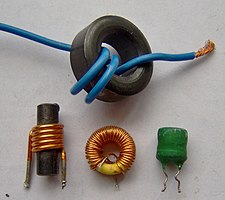Inductor

A selection of low-value inductors
|
|
| Type | Passive |
|---|---|
| Working principle | Electromagnetic induction |
| First production | Michael Faraday (1831) |
| Electronic symbol | |
An inductor, also called a coil or reactor, is a passive two-terminal electrical component that stores electrical energy in a magnetic field when electric current is flowing through it. An inductor typically consists of an electric conductor, such as a wire, that is wound into a coil.
When the current flowing through an inductor changes, the time-varying magnetic field induces a voltage in the conductor, described by Faraday's law of induction. According to Lenz's law, the direction of induced electromotive force (e.m.f.) opposes the change in current that created it. As a result, inductors oppose any changes in current through them.
An inductor is characterized by its inductance, which is the ratio of the voltage to the rate of change of current. In the International System of Units (SI), the unit of inductance is the henry (H). Inductors have values that typically range from 1 µH (10−6H) to 1 H. Many inductors have a magnetic core made of iron or ferrite inside the coil, which serves to increase the magnetic field and thus the inductance. Along with capacitors and resistors, inductors are one of the three passive linear circuit elements that make up electronic circuits. Inductors are widely used in alternating current (AC) electronic equipment, particularly in radio equipment. They are used to block AC while allowing DC to pass; inductors designed for this purpose are called chokes. They are also used in electronic filters to separate signals of different frequencies, and in combination with capacitors to make tuned circuits, used to tune radio and TV receivers.
...
Wikipedia
